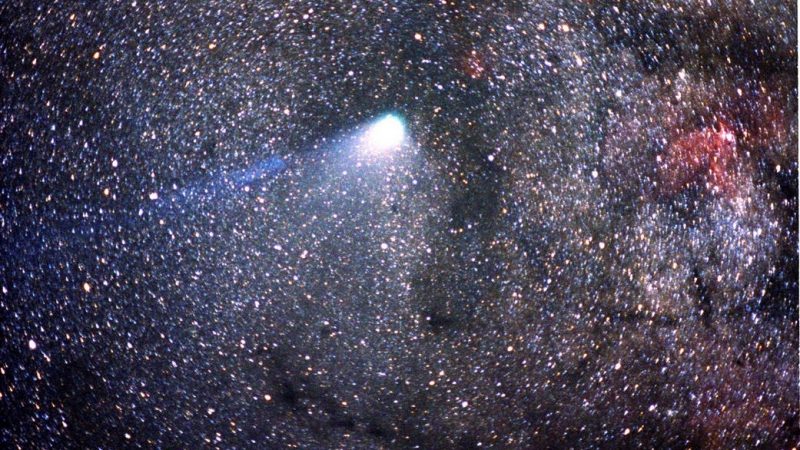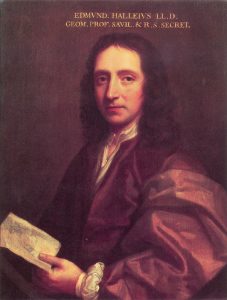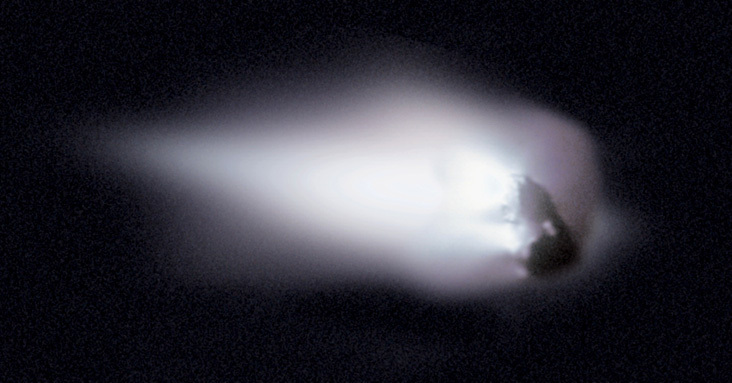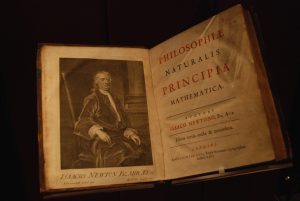When Will Hailies Commet Come Again

How Halley's Comet became famous
English astronomer and mathematician Edmond Halley was born on November 8, 1656, near London. He became the first to calculate the orbit of a comet, still 1 of the nearly famous of all comets today, named Comet Halley in his honor. He was also friends with Isaac Newton and contributed to Newton'southward development of the theory of gravity, which helped constitute our modern era of science, in role past removing all dubiousness that nosotros live on a planet orbiting around a sun.
When Halley's Comet last appeared in Earth's skies in 1986, information technology was met in space by an international armada of spacecraft. This famous comet will return again in 2061 on its 76-year journey around the sun. Information technology's famous partly because information technology tends to be a bright comet in Earth's skies. And the length of its orbit – 76 years – isn't so unlike from that of a human lifespan. So, for nigh people, seeing Comet Halley is a once-in-a-lifetime opportunity.
Simply information technology's also famous for some other reason. That is, in Edmond Halley'south time, people didn't know that comets were like planets in being jump in orbit past the dominicus. They didn't know that some comets, like Comet Halley, return over and over. Comets were thought to pass only once through our solar system.
In the year 1704, Halley became a professor of geometry at Oxford University. The following year, he published A Synopsis of the Astronomy of Comets. The book contains the parabolic orbits of 24 comets observed from 1337 to 1698.
And information technology was in this book that Halley made his magnificent prediction.
EarthSky'due south 2022 lunar calendars are bachelor now! We're guaranteed to sell out, and so get one while you tin. Your support helps EarthSky go on going!

Halley's magnificent prediction
In his book, Halley remarked on three comets that appeared in 1531, 1607, and 1682. He used Isaac Newton'southward theories of gravitation and planetary motions to compute the orbits of these comets. Remarkable similarities appeared in their orbits. Then Halley made a leap and made what was, at that time, a stunning prediction. He said these three comets must in fact be a single comet, which returns periodically every 76 years.
He so predicted the comet would return, maxim:
Hence I dare venture to foretell, that it volition render once again in the twelvemonth 1758.
Halley didn't live to see his prediction verified. It was 16 years after his death that – right on schedule, in 1758 – the comet did return, amazing the scientific earth and the public.
It was the first comet e'er predicted to return, and is now called Halley's Comet, in laurels of Edmond Halley.

Halley, Flamsteed and a Mercury transit
The 17th century was an exciting fourth dimension to be a scientist in England. The scientific revolution gave birth to the Royal Order of London when Halley was only a child. Members of the Royal Society – physicians and natural philosophers who were some of the primeval adopters of the scientific method – met weekly. The first Astronomer Imperial was John Flamsteed, remembered in part for the creation of the Purple Observatory at Greenwich, which notwithstanding exists today.
After inbound Queen's Higher in Oxford as a student in 1673, Halley met Flamsteed. Halley had the take chances to visit him in his observatory on a few occasions, during which Flamsteed encouraged him to pursue astronomy.
At that time, Flamsteed'southward project was to assemble an accurate itemize of the northern stars with his telescope. Halley thought he would do the aforementioned, but with stars of the Southern Hemisphere.
Halley's Southern Hemisphere expedition
His journeying s began in Nov 1676, fifty-fifty before he obtained his university degree. He sailed aboard a ship from the E Bharat Visitor to the island of St. Helena, however 1 of the well-nigh remote islands in the world and the southernmost territory occupied by the British. His father and King Charles II financed the trip.
In spite of bad weather that made Halley'south work difficult, when he turned to sail back home in January 1678, he brought records of the longitude and latitude of 341 stars and many other observations including a transit of Mercury. Of the transit, he wrote:
This sight … is by far the noblest astronomy affords.

Cracking the code of planetary motion
Halley published his catalog of southern stars by the terminate of 1678, and – every bit the first work of its genre – it was a huge success. No one had ever attempted to determine the locations of southern stars with a telescope before. The catalog was Halley's glorious debut as an astronomer. In the same yr, he received his M.A. from the University of Oxford and was elected a fellow of the Royal Society.
Halley visited Isaac Newton in Cambridge for the first time in 1684. A group of Royal Society members, including physicist and biologist Robert Hooke, architect Christopher Wren and Isaac Newton, were trying to crack the code of planetary motion. Halley was the youngest to join the trio in their mission to apply mathematics to describe how – and why – the planets move effectually the sun. They were all competing against i some other to find the solution offset, which was very motivating. Their problem was to find a mechanical model that would keep the planet orbiting around the lord's day without it escaping the orbit or falling into the star.
Hooke and Halley determined that the solution to this trouble would be a force that keeps a planet in orbit around a star and must decrease as the inverse square of its altitude from the star, what nosotros today know every bit the inverse-square police.
Hooke and Halley were on the right track, only they were not able to create a theoretical orbit that would match observations, in spite of a monetary prize to be given by Wren.
Halley visited Newton and explained the concept to him, also explaining that he couldn't prove it. Newton, encouraged by Halley, developed Halley's work into one of the most famous scientific works to this twenty-four hours, Mathematical Principles of Natural Philosophy, oft referred to but as Newton's Principia.

Halley became Astronomer Royal
Halley is besides known for his work in meteorology. He put his talent of giving significant to cracking amounts of information to use by creating a map of the world in 1686.
The map showed the most of import winds to a higher place the oceans, and is considered to be the first meteorological chart to exist published.
Halley kept travelling and working on many other projects, such as attempting to link mortality and age in a population. This data became of import for actuaries computing life insurance.
In 1720, Halley succeeded Flamsteed and became the second Astronomer Majestic at Greenwich.

Bottom line: Astronomer Edmond Halley – for whom Halley's Comet is named – was born on November viii, 1656.
Source: https://earthsky.org/space/halleys-comet-and-edmond-halleys-prediction/
Post a Comment for "When Will Hailies Commet Come Again"